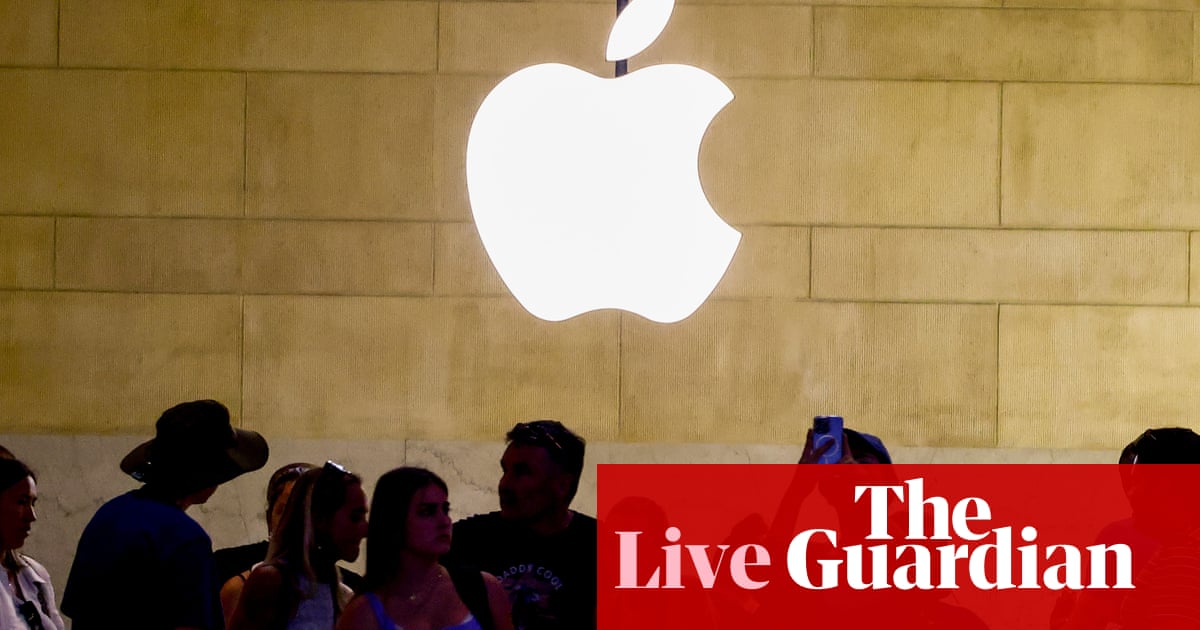Newsflash: Donald Trump has just announced he is recommending a 50% tariff on goods from the Europen Union, from the start of next month.
Ratcheting up the trade war,Trumphas claimed in a Truth Social post that the EU has been ‘very difficult’ to deal with, and that the current US trade in goods deficit is “totally unacceptable”.
Trumpalso claims that the EU was set up to take advantage of the US on trade.
He says:
The stock market rally is over as we head into the long weekend, reportKathleen Brooks,research director atXTB.
She reports:
Here’s some snap reaction to Donald Trump’s threat to impose a 50% tariff on EU imports, starting withBBCeconomics editor FaisalIslam…
….economics professorJustinWolfers…
… analystIan Bremmer…
…and hedge fund managerBennEifert…
Wall Street is set to slump when trading begins.
TheDowJonesindustrialaverageis down 1.5% in premarket trading, with the tech-focusedNasdaqon track for a 1.9% drop,
The EU Commission has declined to comment on U.S. President Donald Trump’s recommendation to put a50% tariffon goods from the European Union from 1 June, Reuters reports.
The Commission said it would wait until for a phone call between EU trade chiefMarosSefcovicand his U.S. counterpartJamiesonGreerto take place at 15:00 GMT.
Brussels may well be surprised by Trump’s move today, as we’re only halfway through the three-month pause on all the “reciprocal” tariffs which the US president announced in early April (after his “Liberation Day” tariff announcement sent markets sliding).
That pause means EU goods currently only incur the new US ‘baseline’ tariff.
The oil price has hit a two-week low afterDonald Trump threatened hefty new tariffs on imports from the European Union.
Brent crude, the international benchmark, has fallen by 1.5% to as low as $63.32 per barrel. Traders will be calculating that a US-EU trade war will hurt the global economy, leading to lower demand for energy.
Trump’s tariffs threats have created a sea of red across European stock markets:
Donald Trump’s two-pronged attackon the European Union, andon Apple, has swiftly destroyed hopes that the trade war was cooling.
There’s been a period of calm in the last couple of weeks, after the US and China agreed a 90-day pause and the elimination of most of the tariffs imposed on each other during April.
The threat of 25% tariffs on iPhones made abroad, and 50% on imports from the EU into America, has brought an end to the peace.
Fawad Razaqzada,market analyst atCity IndexandFOREX.com,says “all the optimism over trade deals [has been] wiped out in minutes – seconds, even”, explaining:
European stock markets are sliding after Donald Trump threatened the EU with a 50% tariff on its goods from the start of June (see previous post).
Germany’sDAXhas fallen by 1.9% as investors digest Trump’s announcement, while Italy’sFTSEMIBhas lost 2%.
TheStoxx600BanksIndex, which tracks bank shares in Europe, is down 1.7%.
In London, theFTSE100index of blue chip shares has now dropped by 101 points, or 1.1%, as trade war fears sweep the City again. Bank stocks are among the big fallers.
Newsflash: Donald Trump has just announced he is recommending a 50% tariff on goods from the Europen Union, from the start of next month.
Ratcheting up the trade war,Trumphas claimed in a Truth Social post that the EU has been ‘very difficult’ to deal with, and that the current US trade in goods deficit is “totally unacceptable”.
Trumpalso claims that the EU was set up to take advantage of the US on trade.
He says:
Apple shares are falling in pre-market trading after Donald Trump threatened the company with new tariffs unless it shifts iPhone production to the US.
They’re currently on track to fall by around 3% when trading begins on Wall Street, in under two hour’s time.
Newsflash: Donald Trump has fired another shot at Apple in his trade wars, warning that the tech giant must pay a 25% tariff unless it manufactures its iPhones in the US.
Posting on his Truth Social website,Trumpsays:
This is the US president’s latest attempt to force Apple to move manufacturing to the US; last week, Trump said he had a “little problem” with Apple’s Tim Cook, after reports that the company isplanning to switch assembly of handsetsfor the US market from China to India.
The battle to take control of UK discount chain Poundland has taken a twist.
Sky News are reporting that Poundland’s owner, Pepco Group, has shortlisted two rival firms to buy Poundland, which needs a capital injection of more than £50m to aid a turnaround plan.
A Pepco insider said on Friday thatHilco, the former owner of HMV and Homebase, and former Laura Ashley-ownerGordonBrotherswere involved in a two-way race to buy the chain.
That means that Modella Capital, the investment firm which has agreed to buy WH Smith’s high street operations, has been eliminated from the auction.
Yesterday, Pepco cut its profit guidance for Poundland, due to “highly challenging trading conditions, which have been further impacted by clearance of old stock and product availability issues”.
Worryingly, productivity in the UK private sector has dropped below its levels before the Covid-19 pandemic.
New data from the Office for National Statistics this morning shows that multi-factor productivity – a measure of how efficiently resources are used in the economy – fell by 0.6% in 2024 and was 0.7% lower than in 2019.
That, the ONS points out, is rather worse than the trend growth in MFP of around 1.8% per year in the decade before the 2008 economic downturn.
The report shows that market sector gross value added (GVA) only increased by 1.3% in 2024, while hours worked rose by 1.8%.
